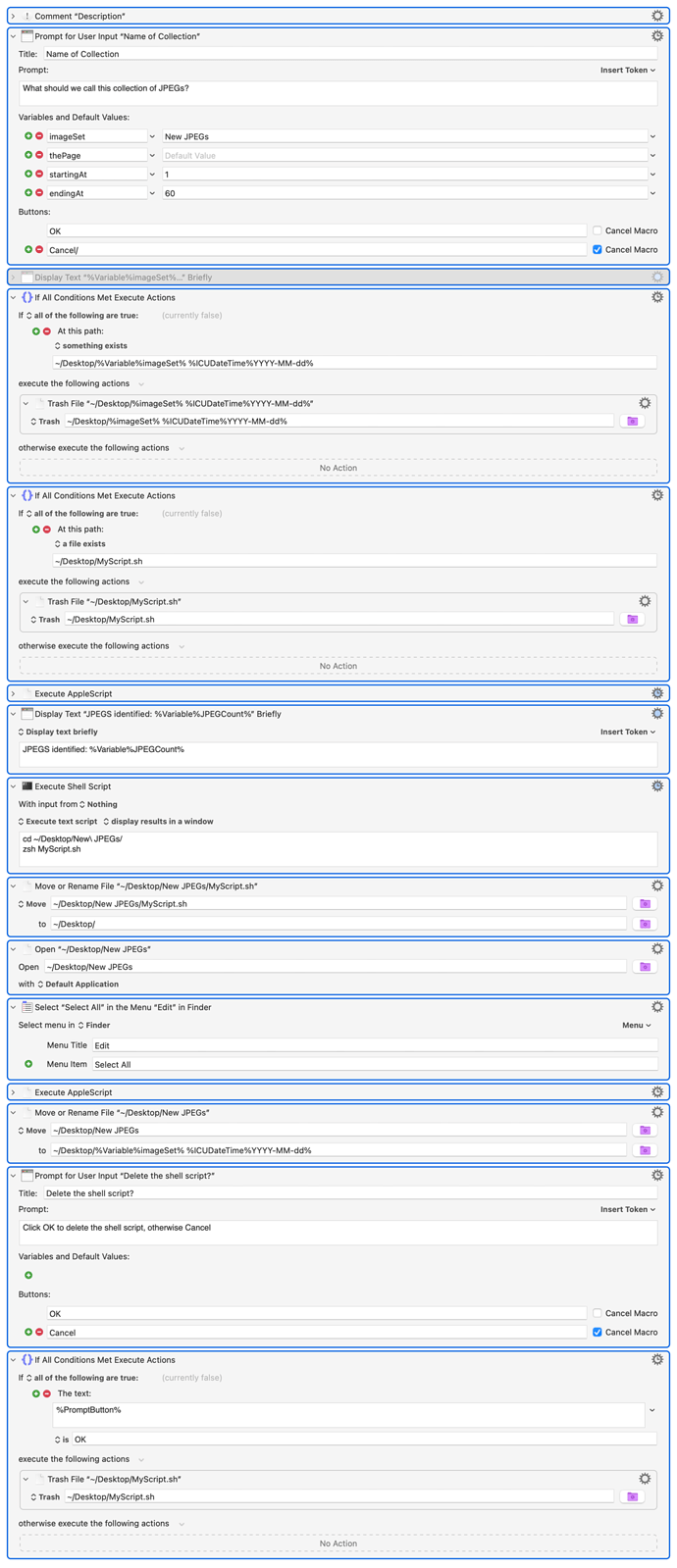Whew! This was difficult, but I did it. You may need to customize it for yourself however. I use it to download high resolution jpeg images from a given URL. I've only tested it on the weekly photos from The Atlantic magazine (I have a subscription in case you're wondering) and use it as desktop wallpaper. It was a lot harder than I realized when I started the project. It uses wget in a shell script to download the images, then renames and numbers the files. Here it is. It could probably be improved, but it works for me as is.
This is an updated working version (3/20/2023).
Added support to eliminate jpegs with <= 600 horizontal pixels.
Added support to eliminate Dropbox thumbnails.
This should work on simple sites that only have jpeg repositories, but beware, every site is different.
Extract JPEGs from URL.kmmacros (26.3 KB)
1 Like
Here is a working version. Still some rough edges, however:
use framework "Foundation"
use scripting additions
--IRN - 2023-03-10 (with help from the LateNightSW website)
--This script extracts the large jpegs at a URL and places the links to them in the clipboard
tell application "Keyboard Maestro Engine"
set thePage to value of variable "thePage"
end tell
set myList to {}
set i to 0
set the clipboard to "#!/bin/bash" & linefeed
set the clipboard to (get (the clipboard) & "## run this from the directory in which the images will be stored" & linefeed & "##" & linefeed)
set myList to its searchFor:"jpg" inURL:thePage
repeat with anItem in myList
set i to i + 1 -- to enumerate the image names
-- add the URL to the list
set the clipboard to (get (the clipboard) & "wget --output-document=original-" & (i as text) & ".jpg " & anItem & linefeed)
end repeat
--display dialog (i as text) & " images to be downloaded, script is in the clipboard"
set fileName to "MyScript.sh"
try
tell application "Finder" to make new folder at desktop with properties {name:"New JPEGs"}
end try
set thePath to POSIX path of (path to desktop)
set myFile to thePath & "New JPEGs/" & fileName
--display dialog "myFile is " & myFile
set myScript to the clipboard -- copy the clipboard into a variable
-- if the file exists alreay, no problem. This will overwrite it
try
set fileDescriptor to open for access myFile with write permission
set eof of fileDescriptor to 0 -- Delete current contents of the file
write myScript to fileDescriptor starting at eof
write linefeed & "exit" & linefeed to fileDescriptor
close access myFile -- Close the file
end try
-- display dialog "Done"
return i
-- all the major work is done here
-- This is magic
--
on searchFor:searchTag inURL:URLString
set theURL to current application's |NSURL|'s URLWithString:URLString
set theSource to current application's NSString's stringWithContentsOfURL:theURL encoding:(current application's NSUTF8StringEncoding) |error|:(missing value)
set dataDetector to current application's NSDataDetector's dataDetectorWithTypes:(current application's NSTextCheckingTypeLink) |error|:(missing value)
set linkArray to dataDetector's matchesInString:theSource options:0 range:{location:0, |length|:theSource's |length|()}
set URLList to (linkArray's valueForKeyPath:"URL.absoluteString") as list
set resultList to {}
tell application "Keyboard Maestro Engine"
set startingAt to value of variable "startingAt"
set endingAt to value of variable "endingAt"
end tell
repeat with anItem in URLList
if searchTag is in anItem then
if (contents of anItem) contains "theatlantic.com" then
-- specialized for theAtlantic
-- could specialize for others as well
if ((contents of anItem) contains "1500") and ((contents of anItem) contains "thumbor") then
-- display dialog (contents of anItem)
set end of resultList to (contents of anItem)
end if
else
-- more specialization could go here
set end of resultList to (contents of anItem)
end if
end if
end repeat
-- next, only return the sublist from startingAt to endingAt, pruning all the rest
set prunedList to {}
if (length of resultList) ≥ (endingAt - startingAt + 1) then
set prunedList to (items startingAt thru endingAt) of resultList
else
set prunedList to resultList
end if
return prunedList
end searchFor:inURL:
use AppleScript version "2.4" -- Yosemite (10.10) or later
use scripting additions
set my_imageSet to ""
tell application "Keyboard Maestro Engine"
set my_imageSet to value of variable "imageSet"
-- display dialog my_imageSet
tell application "Finder"
set _files to selection as alias list
if _files is {} then return display alert "Nothing selected!" as warning giving up after 5
repeat with f in _files
set theoldstring to name of f
set thenewstring to findAndReplaceInText(theoldstring, "original", my_imageSet) of me
set name of f to thenewstring
delay 0.5
end repeat
end tell
end tell
on findAndReplaceInText(theText, theSearchString, theReplacementString)
set AppleScript's text item delimiters to theSearchString
set theTextItems to every text item of theText
set AppleScript's text item delimiters to theReplacementString
set theText to theTextItems as string
set AppleScript's text item delimiters to ""
return theText
end findAndReplaceInText
return
1 Like
